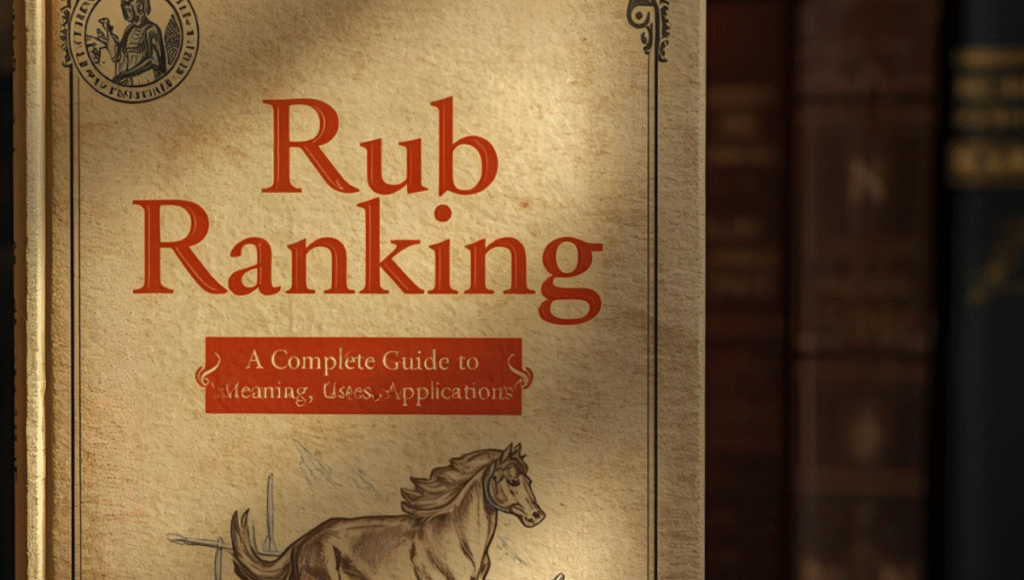In the ever-expanding world of technology, business, and digital analytics, the term “Rub Ranking” has begun to attract attention. While it may sound like a new buzzword, Rub Ranking is actually a system of evaluation and measurement that can be applied across different industries. Whether you’re a student, a business owner, or a digital strategist, understanding Rub Ranking is essential if you want to make better decisions and improve outcomes.
This comprehensive guide will explore what Rub Ranking means, how it works, where it’s used, and why it matters.
What Is Rub Ranking?
At its core, Rub Ranking refers to a scoring or ranking method that evaluates performance, value, or efficiency based on specific criteria.
-
The word “Rub” can be traced back to “Rubrics”, which are structured sets of guidelines used for assessment.
-
The term “Ranking” emphasizes the process of ordering items, individuals, or entities based on their relative performance.
In simple terms, Rub Ranking is a way of scoring or grading things so that you can compare them fairly and effectively.
How Does Rub Ranking Work?
Rub Ranking typically follows a structured process:
-
Define Criteria – Establish the rules or guidelines for assessment.
-
Example: In education, criteria might include creativity, accuracy, and effort.
-
In business, it could include efficiency, cost-effectiveness, or customer satisfaction.
-
-
Assign Scores – Each item or person being evaluated receives a score based on the criteria.
-
Rank the Results – Once the scores are calculated, items are placed in order from highest to lowest.
-
Interpret the Data – Finally, the ranked list is analyzed to draw insights, compare performance, and make improvements.
Where Is Rub Ranking Used?
Rub Ranking is highly versatile and can be applied in many industries. Let’s look at some of the most common areas:
1. Education
Teachers often use rubrics to grade assignments, presentations, or projects. Rub Ranking helps:
-
Provide fair evaluations.
-
Compare student performance.
-
Highlight strengths and weaknesses.
2. Business & Management
Companies use Rub Ranking to:
-
Measure employee performance.
-
Rank suppliers or vendors.
-
Evaluate projects based on profitability, risk, and efficiency.
3. Technology & Digital Marketing
In the online space, Rub Ranking can be used for:
-
Ranking websites based on SEO performance.
-
Analyzing app usability.
-
Scoring social media campaigns.
4. Sports & Competitions
Rub Ranking is used to:
-
Judge athletes based on performance, style, or execution.
-
Compare competitors fairly in events like gymnastics, dance, or martial arts.
5. Customer Experience
Businesses also apply Rub Ranking to customer feedback:
-
Ranking products based on reviews.
-
Identifying best-selling items.
-
Understanding consumer satisfaction trends.Benefits of Rub Ranking
Why should we care about Rub Ranking? Here are some key advantages:
-
Fair Evaluation – Everyone is judged based on the same criteria.
-
Transparency – Scores and ranks are clear and easy to understand.
-
Improved Decision-Making – Helps in choosing the best options.
-
Motivation – Rankings can encourage individuals or teams to perform better.
-
Consistency – Ensures that evaluations remain uniform across different contexts.Challenges of Rub Ranking
While effective, Rub Ranking also comes with challenges:
-
Subjectivity: If criteria aren’t clear, results may be biased.
-
Over-Simplification: Complex performances may be reduced to numbers.
-
Pressure: Individuals might feel stressed about being ranked.
These challenges can be managed by making the criteria detailed, fair, and transparent.
Future of Rub Ranking
With the rise of AI, big data, and analytics, Rub Ranking is becoming more advanced. Instead of manual scoring, automated systems can:
-
Analyze huge datasets.
-
Rank performance instantly.
-
Provide predictive insights.
For example, schools may soon use AI-driven Rub Ranking to evaluate student performance in real-time, while businesses could apply it to predict customer satisfaction trends.
Conclusion
So, what is Rub Ranking really about? It’s a structured method of evaluating and comparing performance across education, business, technology, sports, and customer experience. By providing clear rankings based on specific rubrics, it ensures fairness, transparency, and efficiency in decision-making.
As industries continue to adopt smarter evaluation tools, Rub Ranking is expected to play an even bigger role in the future—helping organizations, educators, and individuals make better choices and achieve higher standards.
👉 Final Thought: Whether you’re a teacher grading assignments, a manager evaluating employees, or a marketer analyzing campaigns, Rub Ranking can help you assess, compare, and improve performance with confidence.
